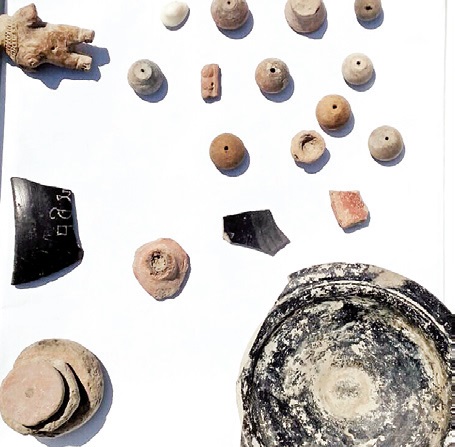Recent excavations conducted by the department of Archaeology and Museums (DAM) have revealed evidence of yet another ancient settlement in Nalgonda district.
The latest site is located in Pajjur village, about 12 km from Nalgonda and 80 km away from Phanigiri Buddhist site, where the department had unearthed extensive Buddhist relics dating back to the 2nd century AD and 4th century AD. A team of archaeologists, who started excavations at Pajjur on February 18, found several pottery shreds and terracotta figures. After digging up to three layers, they have found an underlying brick structure too apart from several coloured beads, shell bangles, toys and female terracotta figures.
“On one of the pottery piece, it was written ‘Buddhasa’ in Brahmi script. But it is too early to call it a Buddhist site. Our investigations reveal that the site should date back to the first and third century AD,” said an official.

In fact, the archaeologists had conducted a preliminary surface excavation at Pajjur in 2003 but with Phanigiri Buddhist site gaining prominence, this site was left unattended. The proposal to conduct further excavations was approved by Central Advisory Board Of Archaeology (CABA) recently after the department conducted a surface examination of the site and forwarded the proposal to Delhi.
Confirming the same, NR Visalatchy, director, DAM, said a ground survey was conducted recently to find surface evidence which had suggested an underlying settlement.
“It is a huge area of up to 40 acres. We had problems in convincing the local farmers about the extent of land needed for excavations. We have taken up work on around 3-4 acres. The surface has been disturbed a lot. Just for agricultural purpose alone, around four feet of earth has been removed. We have found a lot of pottery shreds there,” she said.
According to her, there is no evidence so far to suggest that it is a Buddhist site.
“We are exploring the possibilities. The construction needs to be studied scientifically. The structure looks like a wall more than a Stupa. Whether it is part of a Vihara complex will be revealed during further investigation. Unlike the bricks seen in Viharas, these bricks are extremely of light weight. All the analysis needs to be done,” she explained.
At Phanigiri, the hillock which draws its name from the shape that resembles a snake-hood, the department had excavated structural remains in four aspidal Chaityagrihas, eight votive stupas (both circular and square), a maha stupa, a stone-pillared congregation hall with 64 pillars, three viharas with thick brick walls, sculptured panels, Brahmi inscriptions belonging to Satavahana and Ikshvaku dynasties, coins of Mahatalavarasa, Satavahana, Ikshvaku kings and even Roman coins and Persian pottery were found.
source: http://www.newindianexpress.com / The New Indian Express / Home> States> Telanagana / by Rahul V. Pisharody / February 29th, 2016